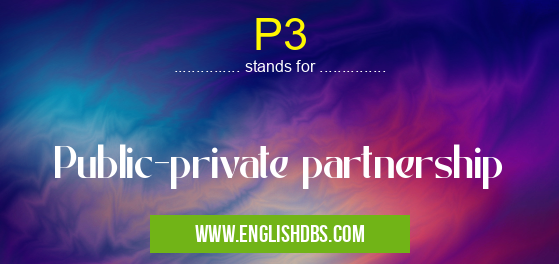What does P3 mean in PLANNING
P3 (Public-Private Partnership) is a collaborative agreement between a government agency and a private sector company to deliver a public infrastructure or service. These partnerships offer a flexible and innovative approach to infrastructure development and service provision.

P3 meaning in Planning in Governmental
P3 mostly used in an acronym Planning in Category Governmental that means Public-private partnership
Shorthand: P3,
Full Form: Public-private partnership
For more information of "Public-private partnership", see the section below.
» Governmental » Planning
### Meaning of P3 in Government:
In the context of government, P3s involve the contracting of private sector entities to design, build, finance, operate, and/or maintain public infrastructure or services. This approach allows governments to leverage private sector expertise, innovation, and financial resources to enhance public service delivery.
### Full Form of P3:
- P - Public
- P - Private
- P - Partnership
### Benefits of P3s:
- Increased efficiency and cost-effectiveness: Private sector partners often bring specialized expertise and innovative technologies, leading to more efficient and cost-effective project delivery.
- Risk sharing: P3s allocate risks between the public and private sectors, reducing the financial burden on governments.
- Access to private sector expertise: Governments can tap into the technical knowledge, project management skills, and financial resources of private companies.
- Acceleration of project delivery: P3s often involve faster project timelines, allowing for the timely completion of critical infrastructure or services.
### Challenges of P3s:
- Complexity and negotiation: P3 agreements can be complex and time-consuming to negotiate, requiring careful planning and experienced professionals.
- Potential conflicts of interest: Ensuring alignment between public and private interests can be challenging, requiring robust governance mechanisms.
- Public accountability: P3s must strike a balance between public accountability and private sector autonomy, ensuring that public funds are used responsibly.
### Conclusion:
P3 partnerships offer a valuable tool for governments to deliver high-quality public infrastructure and services. By leveraging private sector expertise and resources, P3s can enhance efficiency, reduce costs, and accelerate project timelines. However, it is essential to carefully plan and manage these partnerships to address potential challenges and ensure that they align with public interests.
Essential Questions and Answers on Public-private partnership in "GOVERNMENTAL»PLANNING"
What is a Public-Private Partnership (P3)?
A P3 is a collaborative venture between a government entity and a private sector partner to deliver a public infrastructure or service. It combines the resources and expertise of both sectors to achieve mutually beneficial outcomes.
What are the benefits of P3s?
P3s offer numerous benefits, including:
- Increased efficiency and innovation: Private sector partners can bring innovative technologies and management practices to improve project delivery.
- Cost savings: Private sector financing can often lower the upfront capital costs for governments.
- Risk sharing: Both the public and private sectors share the risks and rewards of the project, mitigating potential financial losses.
- Faster project completion: Private sector partners often have incentives to complete projects on time and within budget.
What types of projects are suitable for P3s?
P3s are applicable to a wide range of infrastructure and service projects, including:
- Transportation (e.g., roads, bridges, airports)
- Healthcare (e.g., hospitals, clinics)
- Education (e.g., schools, universities)
- Energy (e.g., power plants, renewable energy projects)
How are P3s structured?
P3s typically involve a long-term contract between the government and the private sector partner. The contract outlines the roles, responsibilities, and risk allocation for each party.
How are P3s financed?
P3s can be financed through a variety of mechanisms, including:
- Public funding
- Private funding
- A combination of public and private funds
P3 also stands for: |
|
| All stands for P3 |
